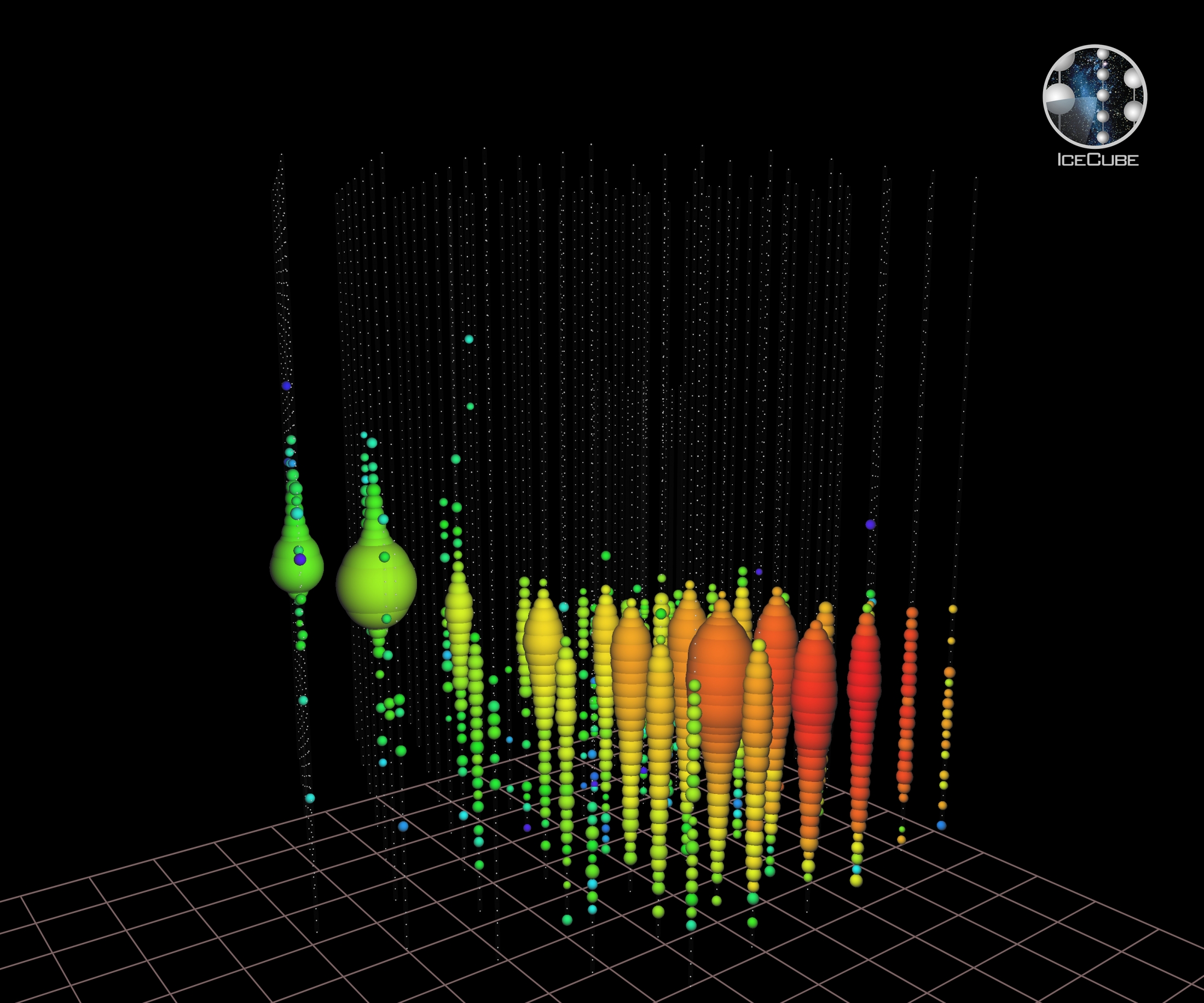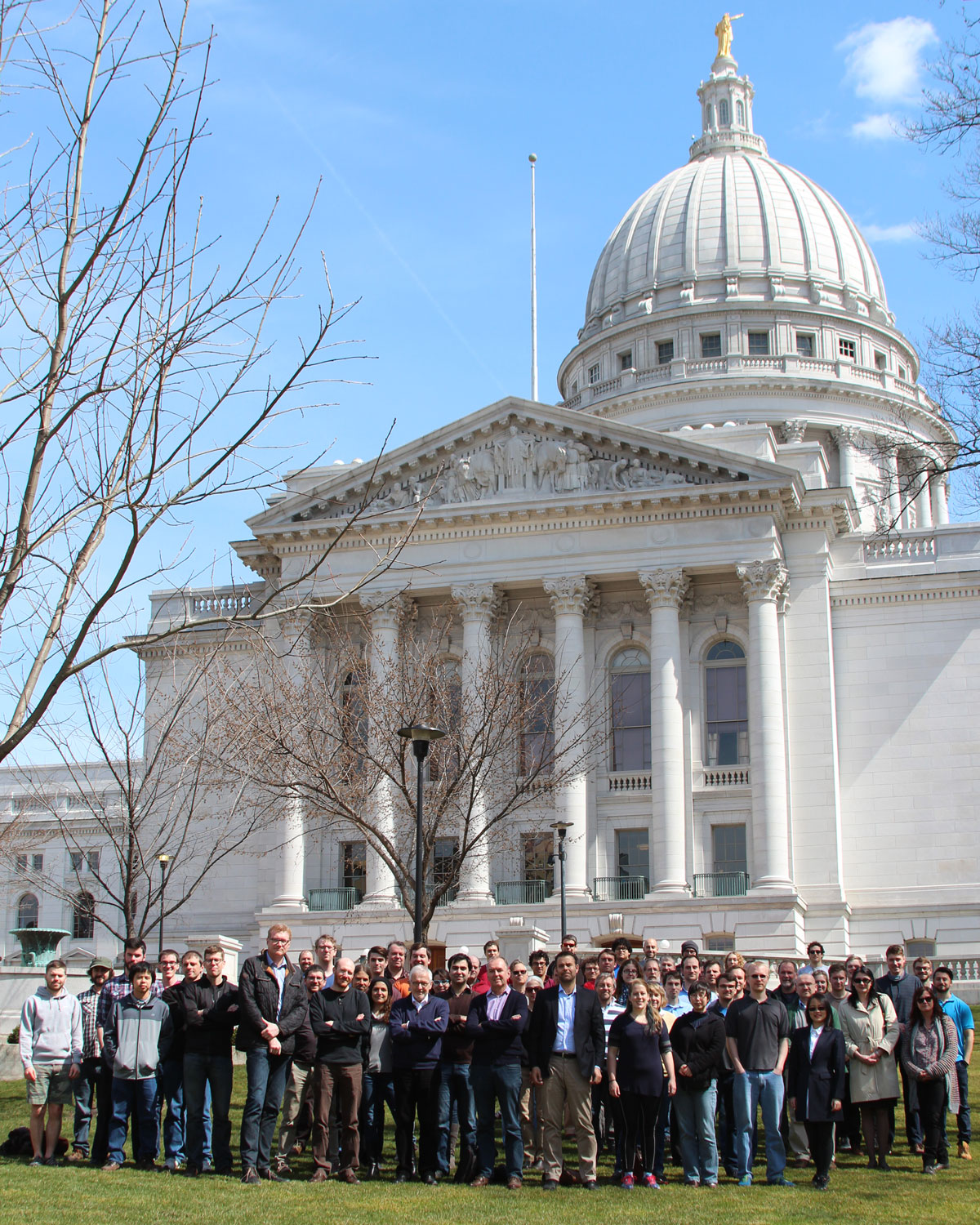The National Science Foundation today, March 30, announced that it has renewed a cooperative agreement with the University of Wisconsin-Madison to operate IceCube, a massive neutrino telescope buried deep in the ice beneath the South Pole.
The five-year, $35 million cooperative agreement calls for the continued operation and management of the observatory located at NSF’s Amundsen-Scott South Pole Station. In 2013, the IceCube scientific collaboration reported the first detection of high energy cosmic neutrinos, opening a new astronomical vista to the universe and some of its most violent phenomena.

Since its inception 15 years ago, IceCube – centered around a detector array consisting of 5,000 optical sensors frozen in the ice a mile beneath the South Pole – has been administered through UW-Madison, in recent years under the auspices of the Wisconsin IceCube Particle Astrophysics Center (WIPAC).
“This is extremely good news,” says Francis Halzen, a UW-Madison professor of physics and the principal investigator for the project. “Over the years we have come to know what it takes to successfully operate the detector.”
Funding for IceCube comes from the Division of Polar Programs in NSF’s Geosciences Directorate and from the Division of Physics in the Directorate for Mathematical and Physical Sciences (MPS). Through the Division of Polar Programs, NSF manages the U.S. Antarctic Program, which supports researchers at universities throughout the country and provides infrastructure to support those researchers in the field.
“NSF is excited to support the science made possible by the IceCube Observatory because it’s at the cutting edge of discovery,” says Scott Borg, head of Polar Programs’ Antarctic sciences section. “But to make ambitious research of this kind a reality requires cooperation within the agency, which is why we’re delighted that IceCube is in partnership with MPS. It’s also science on a global scale, relying on strong international cooperation to be successful.”
IceCube was the first scientific instrument to detect ultra-high-energy neutrinos from beyond our solar system, neutrinos packing a billion times more energy than the neutrinos observed in conjunction with the 1987 supernova observed in the Large Magellanic Cloud. Recent reports from the IceCube collaboration have confirmed the observatory’s detection of high energy neutrinos from beyond our galaxy, so-called cosmic neutrinos.

Neutrinos are nearly massless particles created in nuclear reactions and, in nature, by some of the most energetic events in the universe. Colliding black holes, the violent cores of galaxies, supernovas and pulsars are believed by scientists to be accelerating the high energy particles, many billions of which pass through the Earth every second. Because they have almost no mass and rarely interact with matter, they are excruciatingly difficult to detect and require detectors of the size of IceCube, which occupies a cubic kilometer of Antarctic ice, to capture the fleeting bursts of light created when the occasional neutrino crashes into another particle.
But the elusive qualities that make neutrinos so hard to detect also confer significant insight to science. Since the particles glide through space unhindered by stars, planets and the powerful magnetic fields that pock the universe, it means they are virtually pristine and harbor valuable clues about their yet-to-be confirmed sources.
IceCube has proven to be a workhorse telescope. It is operational 99 percent of the time and, according to Halzen, has so far detected more than a million neutrinos, “a few hundred of which are astronomically interesting.
“Five years ago it was about discovering cosmic neutrinos. Now it’s about doing astronomy and particle physics with them,” notes Halzen of the quest to follow the particles’ tracks back to their sources, a feat yet to be accomplished.
The collaboration that operates the IceCube observatory is composed of individuals representing 47 institutions from 12 different countries and includes sub awards to the Lawrence Berkeley National Laboratory, Penn State, the University of Delaware, the University of Maryland, the University of Alabama at Tuscaloosa, Michigan State and the University of Wisconsin-River Falls.
“All over the world IceCube is considered the flagship of neutrino astronomy,” notes Olga Botner, the IceCube collaboration spokesperson and a professor of physics and astronomy at Sweden’s Uppsala University. “IceCube’s discovery of extraterrestrial neutrinos is a major breakthrough and a crucial first step into as yet unexplored parts of our violent universe. It also represents a step towards the realization of a 50-year-old dream – to figure out what cosmic upheavals create the ultra-high-energy cosmic rays, detected at Earth with energies millions of times larger than those achievable by even the most powerful man-made accelerators.”

Headquartered at UW-Madison, IceCube includes a staff of nearly 60 scientists, engineers and technicians in Madison.
“There are many technical challenges underlying the operation of a large neutrino observatory at the South Pole, many that would be hard to anticipate,” says Kael Hanson, IceCube’s director of operations and a UW-Madison professor of physics. According to Hanson, because of IceCube’s complexity, ability to gather large data sets, and place among the world’s frontline astrophysical detectors, it also contributes to emerging computational technologies for managing and analyzing novel scientific information.
Halzen says the performance of the IceCube detector has steadily improved and a key goal will be to speed up the analysis of neutrinos of interest in order to quickly alert other observatories.
“We’re going to detect interesting neutrinos in real time and we can send word to other observatories,” notes Halzen. “If we can do it in real time, we can be much more effective and we can alert, for example, optical observatories and other detectors” for combined observing.
For example, because neutrinos arrive at the IceCube detector a few hours before photons, the particles that make up visible light, alerts for something like a supernova explosion can be quickly sent to other types of observatories. “With an early warning from neutrino and possibly gravitational wave detectors to all other telescopes, we might have the astronomical event of the 21st century,” says Halzen.
The five-year cooperative agreement begins April 1, 2016, and may be renewed for another five-year period if the detector and collaboration continue to operate successfully.
Contact:
Hilldale and Gregory Breit Distinguished Professor of Physics
University of Wisconsin–Madison
